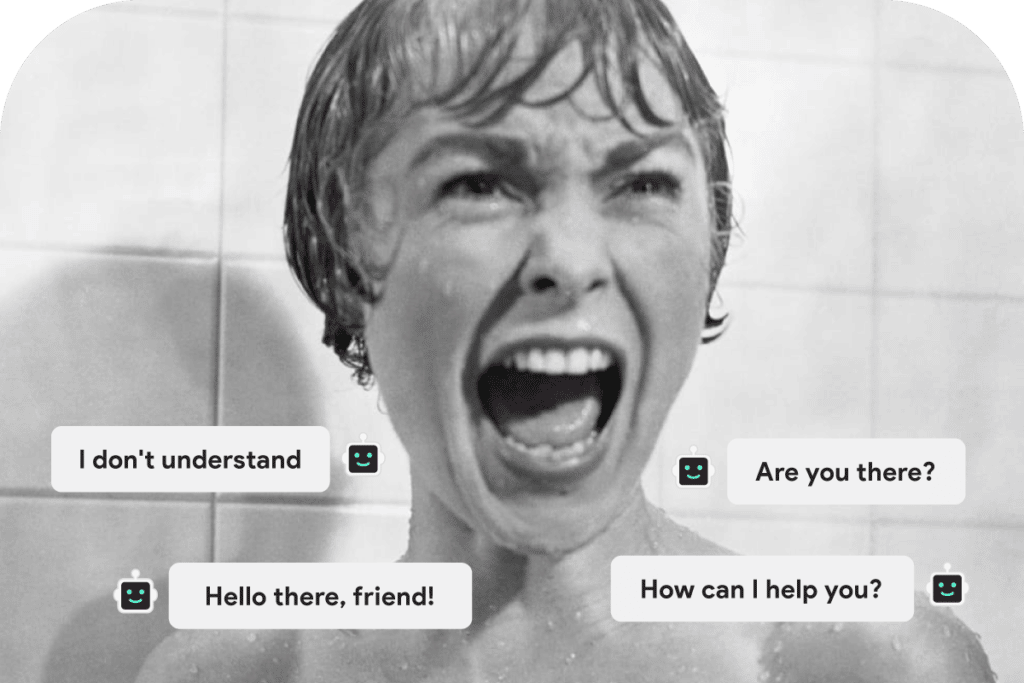Chatbot Horror: How Poorly Designed Chatbots Can Ruin the Customer Experience

By now, you have likely heard how beneficial online chatbots can be. They can help reduce contact center costs by addressing common inquiries and needs, and gathering information to direct messages to the right live agent when necessary. When service agents’ time is freed up from having to ask the same mundane questions over and over, the capacity for service goes up. That means quicker case resolution, higher satisfaction scores and more opportunities to build the personalized, revenue-generating relationships for which they are skilled.
At 1440, we built Messaging Studio to help you design and manage these automated solutions for multiple messaging platforms in one single place. So of course, we’re big fans of the chatbot.
However, the truth is that chatbots may be scaring your customers away if they are not designed correctly.
The goal of Artificial Intelligence is to make consumers’ lives easier, and these days, we’re used to it. The modern consumer experiences some form of it in almost all areas of their lives – from home security and temperature control to subscriptions, weather and vacation planning.
But when it comes to chatbots, some consumers aren’t thrilled. In fact, it’s been found that about 71% of consumers would prefer to interact with real people rather than chatbots or some other automated response.
Of course, we all want the white glove service all the time. But it just doesn’t always make sense to assign a skilled human agent to a task that is repeatable. So, if your business is or plans to incorporate chatbots, take the time to learn what works. After all, you don’t want to scare customers away.
5 Chatbot Scenarios that Make Customers Scream
1. The “I Don’t Understand” Bot
Research shows that people become more frustrated when the chatbots can’t answer their questions like a human in a similar situation. Additionally, human conversations are rarely linear. Conversations between customers and chatbots are only going to run smoothly if they are designed as such. A user may try to change the subject or ask a question to clarify what is happening. Chatbots can only be conversational when they can process subtleties, misspellings, colloquialisms, abbreviations, and jargon.
2. The Pretender Bot
It’s been found that most people want to know if they are speaking to a chatbot. About half of them called a chatbot that’s pretending to be a human “disturbing.” Additionally, over half of the people who were surveyed stated they could tell the difference, and they don’t like being taken for an “idiot.”
Think back to the media backlash caused by Google Duplex when one of these bots called a hair salon to make an appointment with a stylist who had no idea what was going on. The company had promised that the feature would include a built-in disclosure, so it is best to learn from the best (Google in this case) and don’t try to create a chatbot that you are pretending is a human.
It’s also worth noting that in California, it’s illegal for bots to interact with customers, pretend they are human if they sell services or goods, or try to influence a person’s vote in an election. A good rule of thumb is to name your chatbot something that does not sound human, like “1440 Bot”.
3. The Overly Persistent Bot
In some situations, customers want to be left alone when they are using your services. Bots don’t always understand this.
Some companies design their chatbots to “stalk” customers, even when they request the communication to cease in some situations.
However, it is not just smaller business clients who have to deal with the pushy AI-powered chatbots used today. For example, in 2016, the CNN news bot would not understand when consumers entered “unsubscribe.” You must ensure if you are using a bot, it understands when it needs to cease communication with a customer.
4. The Overly Wordy Bot
Like push chatbots, most customers hate when the bot sends huge blocks of text. These are hard to make sense of; in many cases, long messages like this will discourage and even overwhelm some users. This can make them want to leave and never return. Be sure you use chatbots programmed to break up the information to make it more digestible. This will ensure that you hang on to your customers rather than lose them.
5. The Negligent Bot
After your bot has encouraged a user to act, it should make sure to address the action immediately. If there is no follow-up after the customer’s instructions, it shows unreliability. Some of the worst bots we’ve seen are ones that encourage a chat but then have a 24 to 48 hour window for response. If customers see your bot is online, they expect it to respond. Be sure that your bot is living up to the expectations that have been set.
Creating a Positive Experience with the Use of Chatbots
If you decide to use chatbots on your website, you need to ensure they provide your customers with a positive experience. While this can be challenging, there are ways to do this. Knowing the most common bad experiences is a great way to get started. You can also work with a reputable company that provides chatbot services. This is going to help you create the positive experience your customers expect.